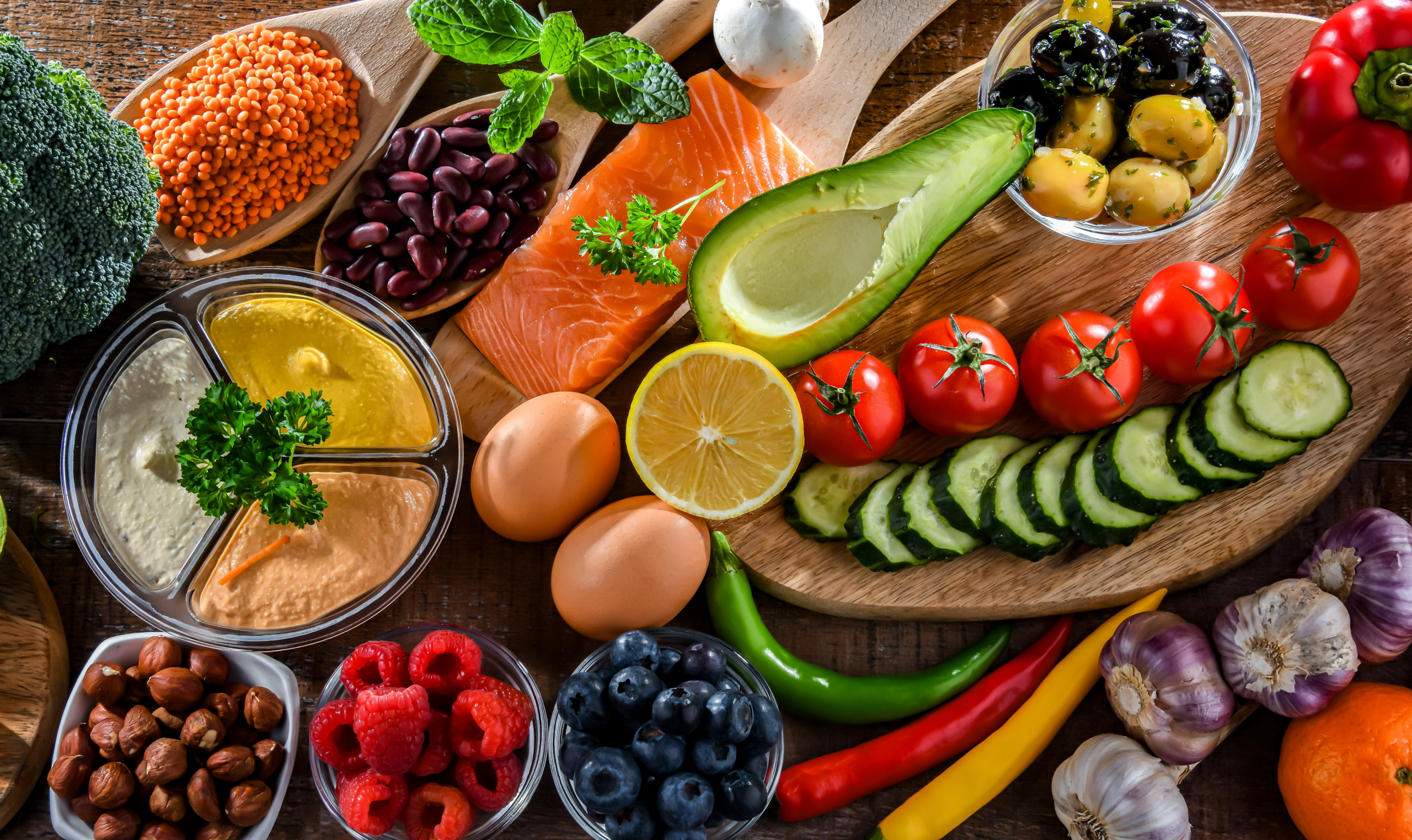Managing diet and exercise are crucial to regulating type 1 diabetes. Although controlling the total number of calories you eat is important, and maintaining your weight is also crucial, it is much more important to understand the relationship between:
- your carbohydrate intake,
- the amount of insulin you intake, and
- the effects the combination of these have on your blood glucose (BG) levels.
The Importance of Eating Nutritious Meals
There will need to be an image (likely a photograph) that appears between the headline above and the paragraph below that portrays an array of healthy vegetables, whole fruits, and grains/nuts that supports the text that appears below.
- It’s critical that people with type 1 diabetes eat meals that contain vegetables, whole fruits, and some whole grains/nuts instead of high-calorie, processed foods such as french fries, potato chips, ice cream, doughnuts, and other desserts that are high in calories, sugar, and saturated fat. It’s also crucial to limit your use of creamy sauces, dressings, and dips with fruits and vegetables, as well as most fast food, especially fried chicken, hamburgers, pizza, milk shakes, tacos, burritos, and barbecue.
There will need to be an image (likely a photograph) that appears between the headline above and the paragraph below that portrays an array of foods high in fiber that supports the text that appears below.
- People with type 1 diabetes need to eat foods high in fiber. These include food items such as beans, whole grains like quinoa and brown rice, fruit with nutritious peels and skins like apples, peaches, carrots, and potatoes, and green, leafy vegetables, such as spinach or kale. Look for foods that contain 2.5 grams or more of fiber per serving. Eating foods that contain fiber slows down your digestion and your body’s ability to absorb food. Both of these things help stabilize blood glucose.
There will need to be an image (likely a photograph) that appears between the headline above and the paragraph below that portrays an array of foods high in protein that supports the text that appears below.
- People with type 1 diabetes need to eat foods high in protein. If you have type 1 diabetes, the protein you consume should be lean and unprocessed. Examples of this include chicken without the skin, fish, eggs, and tofu. Avoid processed meat, such as sausage, hot dogs, pepperoni, beef jerky, deli meats, cured bacon, and canned meat.
- People with type 1 diabetes should avoid sugary beverages, such as soft drinks, sports drinks, and fruit drinks. These drinks have a high glycemic index, which means they cause a rapid spike in BG levels that may be difficult to control for many individuals with type 1 diabetes. Consuming these kinds of beverages can also contribute to weight gain, high blood pressure, heart disease, and tooth decay.
There will need to be an image (likely a photograph) that appears between the headline above and the paragraph below that portrays an array of sugary drinks with a prominent, international “NO” symbol placed atop it.
- People with type 1 diabetes should be extra aware of the kinds of carbohydrates they eat. Carbohydrates are the main source of energy for our body. There are three main types of carbohydrates in our food. They include starches, sugars, and fiber. Starches (found in bread, pasta, potatoes, brown rice, and corn) do not raise blood glucose levels as fast as sugary foods (desserts, juices, cereal, and soda pop). People with type 1 diabetes should limit their intake of sugary foods and choose whole grain, fiber-rich foods instead. They should avoid eating foods that contain processed white flour, such as waffles and pancakes, rolls, buns, white bread, cookies, and crackers.
There will need to be an image (likely a photograph) that appears between the headline above and the paragraph below that portrays an array of foods made from processed white flour with a prominent, international “NO” symbol placed atop it.
- People with type 1 diabetes should cut down on eating foods that contain saturated fat. Examples of such foods include:
- Beef
- Cheese
- Butter
- Palm oil & coconut oil
- Poultry with skin
Additionally, if you have type 1 diabetes, you must also minimize eating foods that contain trans-fat, such as fried foods like potato chips and doughnuts, and many baked goods, including cakes, cookies, crackers, pies, and pastries, as well as stick margarine. Instead, you should consume heart-healthy foods that contain unsaturated fat, such as:
- Fish oil
- Olive oil
- Canola oil
- Nuts
- Avocados
- Peanut butter
The Importance of Reading Food Labels and Counting Carbohydrates:
There will need to be an image (likely a photograph) that appears between the headline above and the paragraph below that portrays an older person, preferably a Latina woman over 50, reading a food label in a grocery store.
If you have type 1 diabetes, you’ll need to learn to read food labels effectively. As you do this, you’ll need to pay particular attention to issues such as serving size, the number of servings per container, and the amount of carbohydrates, fiber, and fat that are displayed. It will also be important for you to learn to accurately measure the serving sizes of whatever foods you choose to eat. This will help you estimate the amount of carbohydrates you consume. Carbohydrates are directly converted to sugar molecules once they’re inside your body, and therefore they have a major effect on BG values. Your insulin-to-carbohydrate-ratio is a measure that estimates the amount of insulin you will need to take to keep your BG under control after you have finished eating. This ratio is initially estimated based on specific, well-established medical formulas. Once you start using this ratio, you can “adjust” this ratio based on the BG response (i.e., the BG reading that you take after eating a meal, which is typically taken two hours later). Your health care provider (HCP), or a certified diabetes educator (CDE) can help you determine the correct insulin-to-carbohydrate-ratio for your body. Determining and then consistently using the insulin-to-carbohydrate ratio that is right for you is perhaps the most important step that helps most individuals with type 1 diabetes regulate their BG levels. Diabetes education is particularly effective for these patients.
Exercising and Type 1 Diabetes
Being active is good for blood glucose control, weight control, and overall health. It also helps reduce stress. The American Diabetes Association (ADA) recommends being active for at least 150 minutes (2.5 hours) spread across 3-5 days per week. Spending 30 minutes doing some type of aerobic exercise, such as walking, running, swimming, riding a bicycle, or dancing daily would be the best way to accomplish this goal. In general, exercise makes you more sensitive to insulin and may make you more prone to hypoglycemia,* also known as low blood sugar (BG), if you have type 1 diabetes. In some patients, certain exercises, particularly isometric (resistance) exercises may cause an increase in their BG number.
The three basic guidelines for type 1 diabetes exercise management:
- eating enough carbohydrates
- monitoring glucose before, during, and after exercise (CGMS, also known as continuous glucose monitoring systems are ideal for this purpose. Some patients use a glucometer for this type of monitoring.
- adjusting insulin as necessary
This article is for educational purposes only. Your HCP and certified diabetes educator can help you develop an individualized and specific meal and exercise plan and insulin dosing system that best suits your situation.
Good luck!
*The definition for hypoglycemia that we’re using in the glossary should appear in one of our pop-ups here.




